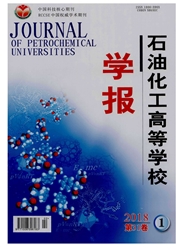

 中文摘要:
中文摘要:
以NaY、HY、液相稀土Ce离子交换改性的Y分子筛(L-CeY)和稀土离子改性的超稳Y分子筛(HRSY-3)为研究对象,在氨气程序升温脱附(NH3-TPD)和吡啶吸附傅里叶变换红外光谱(Py-FTIR)表征其酸性能的基础上,采用原位傅里叶变换红外光谱(In situ FTIR)技术以噻吩和四氢噻吩作为探针分子,研究噻吩硫化物在稀土离子改性的Y型(REY)分子筛上的吸附及转化行为。结果表明,室温条件下噻吩在分子筛强B酸中心作用下即可发生质子化反应,质子化的噻吩分子可进一步发生低聚反应,且稀土物种和非骨架铝有关的L酸中心与B酸的协同作用促进质子化噻吩向低聚物的转化;而四氢噻吩在NaY、HY及REY型分子筛上均无催化反应发生。
 英文摘要:
英文摘要:
Surface acidities of the Y zeolites(NaY,HY,L-CeY and HRSY-3)were characterized by temperature-programmed desorption of ammonia(NH3-TPD)and in situ fourier transform Infrared Spectroscopy using pyridine as probe molecule(PyFTIR).The adsorption and catalytic transformation behaviors of sulfides on Y zeolites modified by rare ions were studied by in situ fourier transform Infrared Spectroscopy(in situ FTIR)technology using thiophene andthiophane as the probe molecules,respectively.The results indicated that thiophene molecules protonated upon the strong Brnsted acid sites of the zeolites at room temperature,then protonated products could further oligomerize.The synergy between L acid sites(included Ce species andnon-framework aluminum species)and Brnsted(B)acid sites was favorable to oligomerization reaction of Thiophene,however,there were no reactions of thiophane over NaY,HY and REY.
 同期刊论文项目
同期刊论文项目
 同项目期刊论文
同项目期刊论文
 Adsorption, Co-adsorption, and Reactions of Sulfur Compounds, Aromatics, Olefins over Ce-Exchanged Y
Adsorption, Co-adsorption, and Reactions of Sulfur Compounds, Aromatics, Olefins over Ce-Exchanged Y Ensemble and ligand effects on the acetylene adsorption on ordered PdxAg1-x/Pd(100) surface alloys i
Ensemble and ligand effects on the acetylene adsorption on ordered PdxAg1-x/Pd(100) surface alloys i Adsorption behaviors of thiophene, benzene, and cyclohexene on FAU zeolites: Comparison of CeY obtai
Adsorption behaviors of thiophene, benzene, and cyclohexene on FAU zeolites: Comparison of CeY obtai 期刊信息
期刊信息
